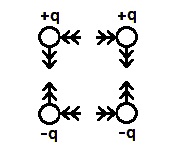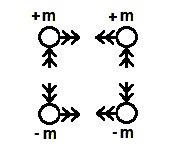Negative mass
The missing piece of the jigsaw
I
want to discuss a concept that has only occurred to me while writing the article on mass and charge
(February
2013).
Of course, this article is pure speculation. As far as I know there is
no hard evidence for negative mass. However this concept does seem to
answer some intriguing questions - why the universe is expanding - why
the expansion is accelerating - the large scale distribution of
galaxies - and even why we do not normally ecounter negative mass in
our world.
For an explanation of unfamiliar terms and concepts in this article, please first read my Mass and Charge article, at least up to Conjecture 6.
Negative mass
Charge comes in two varieties but mass in only one. There seems to be something missing.
If the big bang was caused by a quantum fluctuation, as some believe,
(or any other process for that matter), and assuming you can't get
something for nothing, the energy equation does not balance. To achieve
balance we need a source of negative energy.
I would like to introduce the concept of negative mass. By this I do not necessarily mean antimatter such as positrons or anti-protons etc. I mean mass with the properties described below.
Comparing charge and mass:
|
 |
|
 |
If antimatter particles such as positrons or anti-protons have positive mass and if they form electrically neutral anti-atoms or anti-molecules, these will be attracted gravitationally by 'normal' matter. If they have negative mass, they will be repelled.
A major consequence of negative mass
At, or just after, the big bang when mass came into being, particles having opposite mass would immediately repel each other. The positive feedback effect would increase the repulsion. And because both positive and negative masses existed in equal numbers there was initially no gravitational presence, so no inertia. In an instant, positive masses and negative masses would be accelerated away from each other to relativistic speeds - Inflation with a vengeance.
It's interesting to speculate how this scenario would develop. Regions containing only positive mass or negative mass would form. These would themselves either attract or repel each other. Space-time would be in turmoil, and these regions might even have separated off from one another, resulting in 'universes' with only one variety of mass.
The equivalence principle
It is only when there is numerical equality between the
inertial and gravitational mass that the acceleration is independent of the nature of the body. - Albert Einstein.It has been pointed out to me that there are instances where the concept of negative mass, as I have defined it, seems to violate the Equivalence Principle. My next task will be to understand the implications of this and to see if it is a real problem.
First thoughts
Perhaps the Equivalence Principle only applies when there is one kind of mass. It may only apply when all the masses are either positive or negative. If both were to be present we might have to modify the principle to account for the different behaviour. However, maybe both can only exist together for a instant (as at the big bang), and the conventional view is that the laws of nature did not apply then (which isn't an explanation either).
The evolution of the universe
21 April 2013I have just worked out how the universe could have an equal amount of positive and negative mass, and mass could still exhibit inertia. The Equivalence Principle turns out not to be a problem. The clues came from the large scale distribution of galaxies and my explanation of inertia. (See my Mass and Charge article)
First attempt at an explanation
This explanation is basic. However even with this simple explanation the end result still seems to bear a striking resemblance to the real world.
At the Big Bang, when mass came into being, positive and negative masses came in pairs of particles of opposite-sign mass in random alignments. There would be no universal gavitational presence so no inertia. Pair particles repel each other. Initially lots of scattering occurs but masses with same sign travelling in the same direction would attract and accumulate. Opposite-sign masses repelling causes inflation/expansion. Positive feedback increases velocities. Very high temperatures due to scattering. Electrical and quantum interactions prevent like-mass particles from amalgamating. Matter is in a plasma-like state.
The temperature falls due to expansion. At some stage atoms and molecules are able to exist. This may happen with both the positive and negative-mass particles.
Different places evolve at different rates. Result - random sized mass aggregations, randomly positioned, some positive mass some negative mass. Same-mass aggregations attract each other. Opposite-mass aggregations repel. Because mass aggregations consist of many particles they are deformable. Squeezed between opposite-mass aggregations. Stretched between same-mass aggregations. Result - nodes, filaments and voids. Interwoven 3D net-like structures of each type of mass form, never touching but always evolving by squeezing and stretching into new similar but larger structures. These structures are similar to the coarse foam of a texture-paint roller. I am going to call these structures 'meganets'. The masses in an individual meganet all have the same sign.
Surface tension acts at the surface of the meganets. This could cause filaments to break up. Over time, the same-sign meganets link up in some places and separate in others. There could eventually be only two interwoven structures, one having only positive mass and one only negative, still repelling one another.
Inside the nodes and filaments of the meganets, masses have inertia due to the local gravitational presence of surrounding masses of the same sign. Overall, the presence of structures of different signs outside a particular meganet, cancels. That is, there is no overall universal presence, but there is local 'universal presence' inside the nodes and filaments of each meganet. The Equivalence Principle is valid only within a meganet.
Attraction between smaller mass-aggregations, travelling at different velocities within a meganet, causes rotation. These rotating mass-aggregations become rotating galaxies.
Our world exists inside such a structure. The meganets are now vast, comprising millions or even billions of galaxies. In our region, masses have inertia, and the Equivalence Principle is valid, as it would be in a meganet with mass of the opposite sign. It is possible that meganets of opposite mass appear indistinguishable in normal observation, except that our meganet will be attracted by the nearest same-mass meganets and repelled by the nearest opposite-mass meganets. Beyond these nearest structures everything will be moving away due to general expansion.
The structure of the meganets
Imagine a mass of soap bubbles. Equate this to the distribution of mass in the universe. The space inside the bubbles are the voids. The surface where two bubbles meet is also empty space. The edges where three bubbles meet are the filaments and the junctions where four or more bubbles meet are the nodes.
If this first structure is positive mass, the negative mass is distributed as follows. At the centre of each void is a node. Filaments extend through the equivalent of the bubble surfaces to surrounding nodes forming a similar distribution to that of positive mass.
Images of the meganets
Before I discovered negative mass, the large scale distribution of the galaxies was a puzzle. I had worked out that surface tension at the surface of the nodes and filaments plays a part in the evolution of the structures but the origin of the voids was a mystery, as was the cause of the universe's expansion. This is an impression of how I imagined the large scale distribution of the galaxies prior to investigating negative mass.
 |
When I added negative mass to the scenario, everything began to make sense. This an impression of the large scale distribution of galaxies showing both positive and negative mass meganets.
 |
Why positive and negative mass regions should appear the same
If negative mass manifests itself as particles and atoms in the same way as positive mass, then e.m. radiation should be produced in the same way in both positive-mass and negative-mass regions. This radiation should be identical as the properties of charge should be the same in both regions. If this is so, both types of region will appear the same as far as e.m. radiation is concerned.
Refer to Conjecture 6 in the Mass and Charge article.
- On a cosmic scale and to a first approximation charge exhibits radiation but no presence, and mass exhibits presence but no radiation.
You would think that the sign of the mass in a particular region can be determined by whether mass in our region is attracted to it, or repelled by it. However it is difficult to determine whether we are being attracted by a positive-mass region (like the supposed Great Attractor) or being repelled by a negative-mass region in the opposite direction. To make things even more difficult, if we are in a filament that is in the process of breaking up, we will be moving towards one positive-mass node and away from another.
The expansion of the universe
The most obvious indication of the existence of negative mass is the repulsion that results in the expansion of the universe. This repulsion, and therefore the acceleration of the expansion, was greater in the past and will get less in the future as the distance between the meganets increases. If this is so, the acceleration was at a maximum at the Big Bang and is decreasing with time. Eventually, the velocity of expansion will be almost but never quite constant.
We should examine, in detail, the large scale distribution of the galaxies to determine whether or not there are two separate interlocking structures.
I contacted Helene Courtois, whose wonderful graphics of large scale galaxy distribution and cosmic flows can be found at http://www.youtube.com/user/HeleneCourtois, to see if she had found any evidence of two net-like structures. This is her reply:
Dear Mike,
I am sorry I can't answer your question, obviously in this century we are only at the stage of detecting light = stars = mass.
And the definition of "net" is related to density criterion. You can always identify a super-net which is built from lighter nets, etc, all these are still made by mass.
I tried to understand your web article without much success.
Best wishes in your research,
Helene Courtois
Assoc Prof Univ Lyon
Head of the "Observational cosmology/Euclid" group at IPNL
More things to consider
-
Acceleration towards reduces attraction/repulsion, Acceleration away increases attraction/repulsion. How does this affect the evolution of the meganets?
-
Clocks run slower close to a positive mass. What about close to a negative mass?
-
If the Big Bang were gravitationally neutral, clocks nearer to the Big Bang did not run slower.
-
If the Big Bang were only positive mass, clocks ran slower the closer they were to the Big Bang. Clocks would have been stopped at the Big Bang. If time stood still how could the universe have started to expand?
If the red shift of distant galaxies can be completely explained by the speed of recession (gravitational red shift of the Big Bang not needed) this would indicate that the Big Bang was indeed gravitationally neutral.
-
Is space-time flat, on average, because the universe has equal amounts of positive and negative mass?
-
The origin of space and time. One pair (or quadruplet) of matter particles coming into being at a time? Effect of no inertia?
- As I understand it charge requires four tensors to describe it's properties while mass requires ten. If mass is on the same footing as charge this greatly simplifies the description of mass.
- Mass requires the Higgs field to explain its existence but charge does not require such a field. If mass is on the same footing as charge it does not require the existence of the Higgs field.